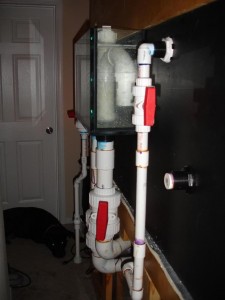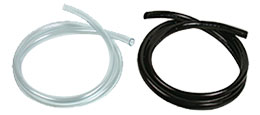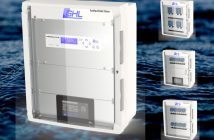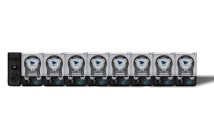Everyone plumbs their aquariums differently. Some choose a simple approach while others opt for a wildly complex system of valves, elbows, and unions. The ultimate goal in mind being water movement from the tank to the filters and back, or possibly water flow within the aquarium via the closed loop system. There are two main types of plumbing seen in saltwater aquariums, soft plumbing and hard plumbing, and each has their benefits and drawbacks.
Soft Plumbing
I’ll start with the simpler of the two plumbing methods. Soft plumbing is accomplished by using flexible tubing and barbed fittings with hose clamps to attach the tubing. The tubing can be vinyl, corrugated tubing, or even flexible PVC, which doesn’t use barbed fittings. Flexible PVC is somewhat more advanced and more difficult to work with than vinyl or corrugated tubing, so we’ll just focus on the latter two forms of tubing for the remainder of the article.
Photo Courtesy of Marine Depot
Vinyl tubing is very easy to work with and comes in a variety of colors. The typical vinyl tubing is clear, but black, green, blue and other colors are available. This tubing can be cut to length very easily and pushed onto a barbed fitting with little to no trouble whatsoever. Additionally, if you ever want to alter your plumbing scheme, flexible tubing can easily be cut and added to or replaced if damaged. Lastly, when using this plumbing method, you won’t have to glue anything together or use elbows to get to the desired location. This saves on time and will keep your water flow from being restricted.
Photo Courtesy of Marine Depot
Vinyl tubing also has its shortcomings. For starters, it cannot handle much pressure. If you want increased water flow, you should go with PVC plumbing. Also, kinks and holes can develop in the tubing causing loss of water flow, microbubbles, or even leaks. Algae can grow inside of clear tubing, blocking water flow and possibly leading to aquariums overflowing.
Hard Plumbing
The second common method of aquarium plumbing is using PVC pipes. PVC comes in different types as well, for example Schedule 40 and Schedule 80 PVC. The difference between these two very common forms of PVC is their thickness and color. Schedule 40 PVC is the white piping you see at the local hardware store and is thinner than Schedule 80. Schedule 80 PVC is black and more expensive, but can withstand more pressure than Schedule 40. Most aquariums can get by with Schedule 40, but certain applications require Schedule 80, and sometimes people just prefer the look of black PVC since it doesn’t stand out as much. Another cool feature of using hard plumbing is that, if done right, you could completely disassemble and reassemble the entire plumbing system without having to re-glue or cut any pieces of PVC.
The main drawbacks to using PVC is that it is more permanent (therefore harder to alter down the road) and requires gluing and proper planning. If you don’t plan the route of the hard plumbing, you could end up spending a lot more money than you would have liked since you would have to replace various parts throughout. Also, once the PVC is glued into place, it cannot be removed other than cutting it out. Placing a PVC fitting, such as a T-fitting, into the wrong place will probably force you to cut out the fitting, throw it away and have to buy a replacement. The gluing and prepping of the PVC is also quite messy. The PVC primer soaks into everything (and won’t come out) and the glue will drip everywhere. Lastly, other than the glue and primer, PVC requires some tools to get the job done. You will need a set of PVC cutters, or at least a PVC saw, Teflon tape for any threaded connections, and you will probably take several trips back to the hardware store, which can be very expensive, with some parts hitting $10, $20, or even $30 depending on the size.
Overall though, hard plumbing is the most ideal setup for most aquariums, in my opinion. Smaller aquariums can get away with soft tubing, but the tubing always kinks at some point. You might get leaks with either setup, and your patience will be tested. But hang in there and recruit experienced aquarium plumbers if need be.









